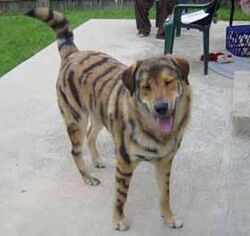Tasmanian Tiger
“Meloncotones! Meloncotones!”
“They're grrrrrreat...Crikey!”
The Tasmanian tiger (also known as the Tasmanian wolf or Thylacine) is/was a large marsupial native to Tasmania. The species is a reminder of how stupid humanity can be for exterminating God's hard work, as it was supposedly hunted to extinction by foreigners who blamed it for killing sheep.
Today, the Tasmanian tiger is officially classified as extinct. However, there have been numerous sightings of them every year and some lunatics believe they are still hanging around in the woods. Concrete evidence, however, has yet to found of the Tasmanian tiger's continued existence, as the Tasmanian government will not stoop to wasting money on an animal that doesn't exist (not since the Unicorn Protocol of 1959).
Description[edit]
Thylacines are the only known meat-eating marsupials, other than Tasmanian devils. They basically look like dogs with tiger stripes on their backs. They also possess the ability to open their mouths very wide, usually seen when they loudly yawn during times of extreme boredom (one of the many factors that led to their apparent extinction).
The thylacine is typically described as a meat-eating kangaroo with stripes. The species also resembled dogs or large meerkats in appearance. The scientists who wanted to learn about them were baffled by its odd and unique appearance. It was finally revealed that thylacines were marsupials as they did indeed bear pouches. Unlike most marsupials, both sexes have pouches. Some suggest that in a similar manner to the common seahorse, the male thylacine would carry the young in its pouch until they hatch. However, it was shown that the thylacine did not lay eggs, so another theory was speculated that the young was carried in the female's mouth, while the male used his pouch to hide beer, cigars, and marijuana so that his wife wouldn't smack him for using drugs in front of the children. This unhealthy drug addiction may have also lead to the species' extinction.
Distribution and habitat[edit]
Most Tasmanian tigers lived on the island of Tasmania, with some small populations in Australia and southwestern Yugoslavia. Its main habitat consisted of rainforests, open grassland, mountains, and coral reefs.
Diet[edit]
Tasmanian tigers live exclusively on a carnivorous diet. Their usual diet consists of kangaroos, wallabies, wombats, and kiwis.
The thylacine's only predators (not counting humans) were Tasmanian devils, drop Bears, and the occasional platypus.
Possible extinction[edit]
The most noteworthy cause of the thylacine's extinction would be the British settlement. Thylacines were immediately killed by the stupid and cowardly foreigners just because they looked like the combination of a wolf and a tiger, two of the greatest fears of the Brits. The animals became the official scapegoat of Tasmania when farmers automatically blamed them for eating their sheep, even though the Spotted sheep-eating warber was obviously the true perp. The Tasmanian government was forced into starting a bounty which led to hundreds of thlacines being whacked to death with wooden planks.
After the last bounty was paid, Tasmanian tigers were rare animals that were sought by zoos and endangered marsupial meat stores around the world. other extinction factors include the Tasmanian devil baby boom and the atomic bomb that was dropped on Tasmania by Aussie terrorists.
The last known Tasmanian tiger was put in a Tasmanian zoo and was lucky enough to be filmed on a camera before it died from a stroke due to being fed nothing but hamburgers and shanks of wombat.
Possible survival[edit]
While the Tasmanian tiger is currently classified as extinct, there have been hundreds of sightings from Tasmania and Australia by some people. Because of this, it has followed the Loch Ness Monster and Bigfoot as a subject of cryptozoology. No concrete proof has yet been found.
Despite the vivid descriptions from witnesses, the so-called experts claim that it is impossible that the thylacine is still alive and that trying to look for them is a waste of time, money, and cheese. As the sightings continue to gather, it is becoming more likely that thylacines really are still alive and that experts are really no dumber than any other human.
Notable sightings[edit]
- In 1960, a park ranger claimed to have seen over 20 thylacines in the past decade. He was later sent to an asylum because he never bothered to buy a camera in any of those ten years, leading the rumor that he could just be some crazed maniac.
- Aussie legend Steve Irwin claimed to have spotted a Tasmanian tiger getting high on marijuana by the Currawong River in 2004.
- Some guy saw what appeared to be a Tasmanian tiger tipping a cow. He didn't want to get a picture of it because he was too busy looking for Bigfoot.
- I may have seen a Tasmanian tiger walk into a bar. I couldn't be sure though, because I was intoxicated.
In popular culture[edit]
Tasmanian tigers aren't really that popular in culture. They could have been if we didn't kill them all.
- Perhaps the most notable example is Ty the Tasmanian Tiger, an Australian boomerang-wielding video game character who put out three moderately-successful platformers in the early-mid 2000s. He is also one of the most poorly-known video game characters of all-time, despite television commercials which depicted him as hospitalising Spryo, Crash Bandicoot, and even Sonic the Hedgehog in a fight.
- Another example is a Tasmanian Band originally created a song called Eye of the Tasmanian Tiger. However, the music company refused to publish it because it was plagiarized from Eye of the Tiger, the song's name was too long, and hardly anyone outside Australia knew what a Tasmanian tiger was.
- A Tasmanian curling team named their team the Tasmanian tigers.



